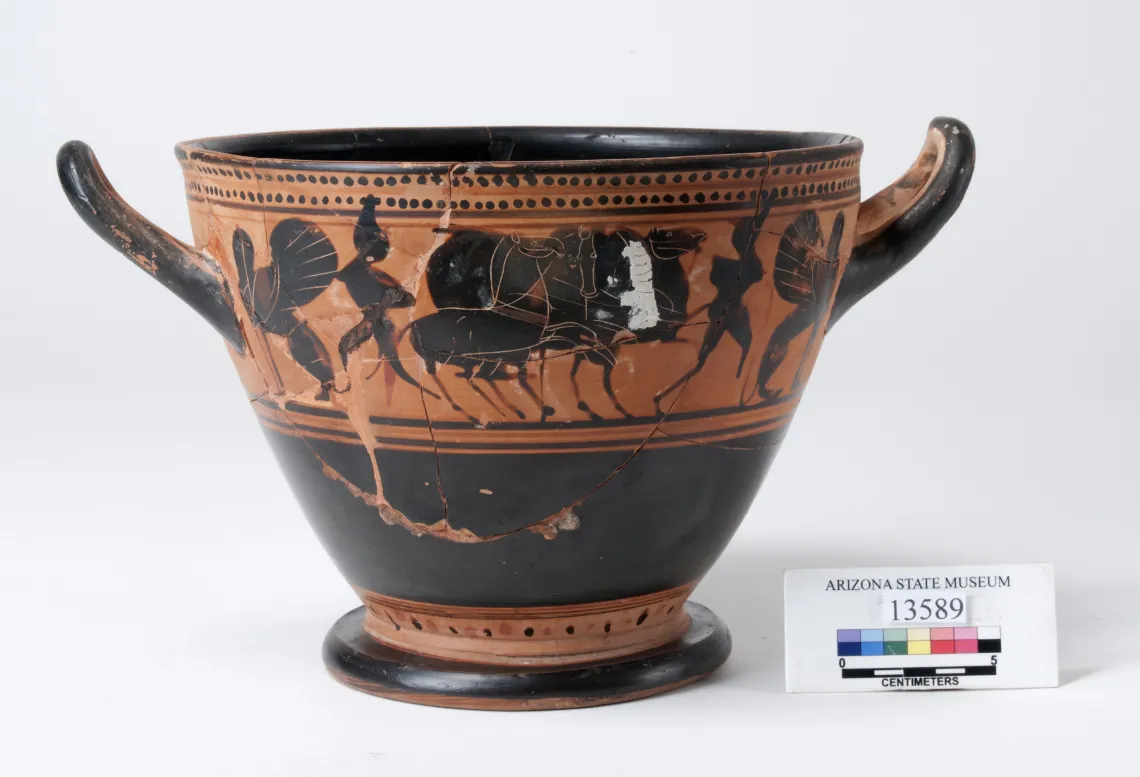
Attic Black Figure Skyphos, CHC Group of Painters, Greek, Late Archaic Period, ca. 500-490 BCE, Manufactured in Attica, Fired pottery, Gift of Governor George W. P. Hunt, 1925, ASM 13589.
Ancient Mediterranean Collections
This online exhibit presents highlights of ASM’s collection of some 520 ancient Near Eastern, Egyptian, Greek, Etruscan, and Roman objects. The vast majority of these were acquired in the early days of the museum’s history from the 1890s to the 1930s through exchange, donation, and less commonly, by purchase. Each has an individual story to tell—where it was made, where it was found, its historical importance, or of its collector.
Research for this display was conducted by Dr. Irene Bald Romano, ASM curator of Mediterranean archaeology, with UA graduate students Christopher C. Baker, Chantel N. Osborne, Emilio Rodriguez-Alvarez, Jessica Sue Wiles, as well as other students and UA colleagues. Study of these collections is ongoing.
More on Dr. Romano's research on ASM's ancient Mediterranean collections can be found here and in this video.
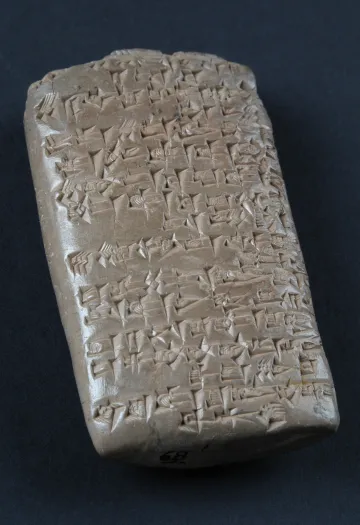
Cuneiform Tablet, Sumerian, UR III period, 2056 BCE, Tell Jokha, Iraq; ancient Umma, Mesopotamia, Baked Clay, Purchased from Edgar J. Banks, 1914, ASM 68.
These wedge-shaped symbols, known as cuneiform (Latin: cuneus = wedge), represent one of the earliest forms of writing. The language on this clay tablet is ancient Sumerian, and it records a court proceeding concerning the non-delivery of barley to the threshing floor of the ruler’s palace. It is the oldest legal text in Arizona.
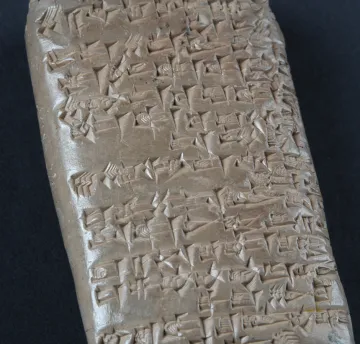
Detail.
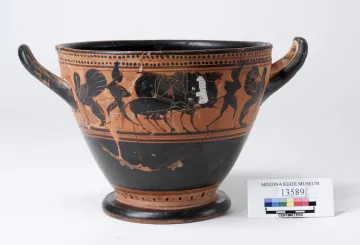
Attic Black Figure Skyphos, CHC Group of Painters, Greek, Late Archaic Period, ca. 500-490 BCE, Manufactured in Attica, Fired pottery, Gift of Governor George W. P. Hunt, 1925, ASM 13589.
The technically sophisticated black figure technique of decorating Greek pottery was perfected in the region of Attica, in and around Athens, in the 6th century BCE. This very large drinking cup is one of the many decorated by a group of painters known as the CHC (CHariot Courting) Group, named for scenes such as this with a four-horse chariot team wheeling around, flanked by seated sphinxes and Amazons wearing tall, pointed caps.
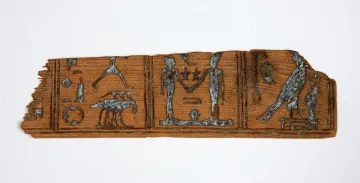
Ancient Egyptian senet board fragment from ASM's permanent collections
This rare, wooden slab-style Egyptian senet board was given to the Arizona State Museum in 1922 by Lily S. Place, an American who lived in Cairo in the 1910s and 1920s and purchased ancient Egyptian objects from dealers and in the bazaars; it has no ancient provenience. Using a multi-disciplinary approach, a team of UA and other scholars have provided a reading and interpretation of the incised hieroglyphs, established a radiocarbon date for the game board from 980 to 838 BCE, identified the wood as Abies (fir), probably Abies cilicica, demonstrated that the board was fashioned from freshly-cut wood, and identified the inlay substance as a green copper-wax pigment. Read much more about this piece here.
Summary: This article discusses a fragment of a rare, wooden slab-style Egyptian senet board that was given to the Arizona State Museum, University of Arizona (Tucson, Arizona) in 1922 by Lily S. Place, an American who lived in Cairo in the 1910s and 1920s and purchased ancient Egyptian objects from dealers and in the bazaars; it has no ancient provenience. Using a multi-disciplinary approach, the authors provide a reading and interpretation of the incised hieroglyphs, establish a radiocarbon date for the game board from 980 to 838 B.C.E., identify the wood as Abies (fir), probably Abies cilicica, demonstrate that the board was fashioned from freshly-cut wood, and identify the inlay substance as a green copper-wax pigment.

Glass Toilet Vessel, Roman Early Imperial period, late 1st century CE, Probably manufactured in Syro-Palestinian region; purchased in Tarsus, Turkey Blown Glass, Gift of Ina E. Gittings, April 1963, ASM A-22901.
After the development of glassblowing in the 1st century BCE, the technique spread rapidly from its origins in the Syro-Palestinian region into neighboring areas, and eventually across the Roman world. Many small vessels were made to hold precious oils and perfumes, powders, cosmetics, and medicinal substances. The term unguentarium (unguent holder) is generally used for the smallest of these; they were commonly deposited in graves throughout the Roman period. The striking iridescence on many examples of Roman glass is a byproduct of the breakdown of the vessel’s chemical components (silica and soda).
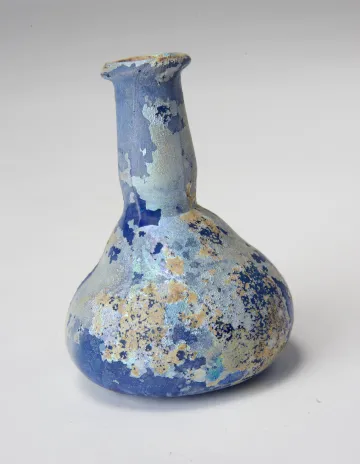
Glass Toilet Vessel, Roman, Early Imperial period, middle to late 2nd century CE. Possibly manufactured in Cyprus or eastern Mediterranean; purchased in Cyprus. Blown glass. Gift of Jennaveve Johns Hawley (UA Class of 1919), 1931. ASM 19646.
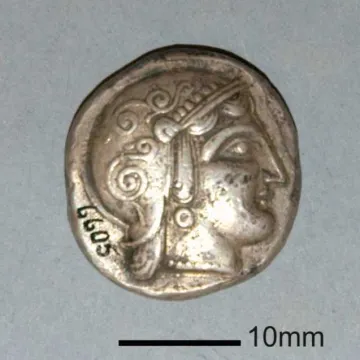
Tetradrachm of Athens, Minted in Athens, Greece, 515-480 BCE Silver. Gift of Governor George W. P. Hunt, May 1932. ASM 6605.
Images of a city’s patron god or goddess, such as Zeus, Apollo, and Athena, are usually portrayed on ancient coins. After the establishment of monarchies at the end of the Classical period these images of divinities were replaced by depictions of rulers, starting with Alexander the Great (upper right). The silver drachm, equivalent to six oboloi, was the basic unit in Greek coinage, the average of two days’ pay of a work in Classical Greece. Each tetradrachm (4 drachmai or 24 oboloi) was the average equivalent of eight days’ salary, enough to maintain an average household. Discrepancies in the weight and the details of the obverse and reverse of some of these coins indicate that they are possible modern copies.
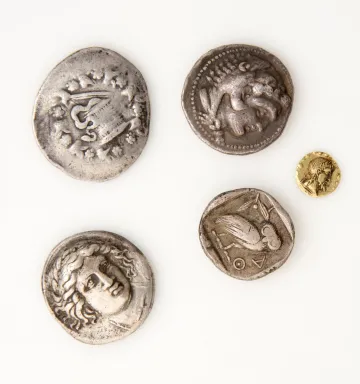
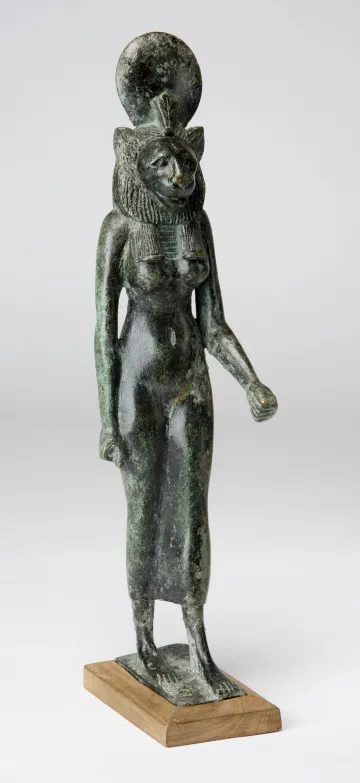
Sekhmet Votive Statuette, Egyptian, modern copy after Ptolemaic Period, ca. 332-20 BCE, Manufactured in Egypt, Cast bronze, ASM 13192. Gift of Lily S. Place, May 1924.
The seated figure of the goddess Isis holds her young son Horus (Greek and Roman Harpocrates) in her lap in a nursing pose. Consort of the underworld deity Osiris, Isis found great popularity among Greeks and Romans who spread her cult throughout the Mediterranean. The imposing figure of the lioness represents the goddess Sekhmet, who was associated with pestilence, warfare, and vengeance. She was also the daughter of the sun deity Re, which explains the solar disk on her head. Votive statuettes such as these would have been offered in sanctuaries by devotees who hoped to curry favor with a certain god or goddess. In antiquity, these types of statuettes would have been cast in the lost wax method, but as these are very heavy and solid cast they are likely to be modern copies.
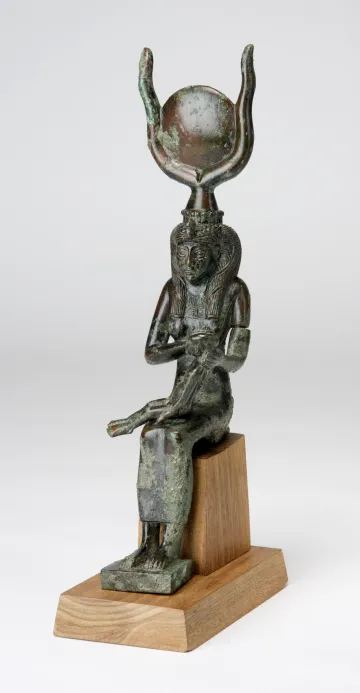
Isis Votive Statuette, Egyptian, modern copy after Ptolemaic Period, c.a 332-30 BCE, manufactured in Egypt, Cast bronze, ASM 13194. Gift of Lily S. Place, May 1924.
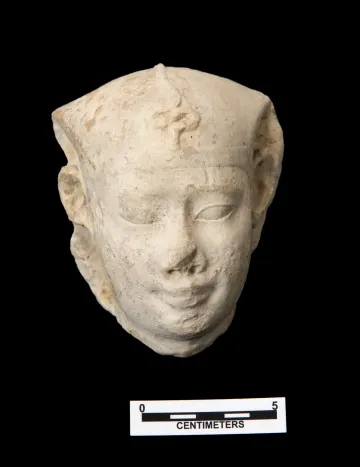
Ptolemaic Royal Portrait, ASM 13202. A small limestone Ptolemaic royal portrait bust, purchased in Cairo and donated to ASM in 1924 by Lily S. Place.
The portrait is in Egyptian style, i.e., in the mode of an Egyptian pharaoh wearing the nemes with uraeus, and can probably be dated to the late fourth or third centuries BCE. A lack of inscriptions and solid archaeological contexts for the majority of small Ptolemaic portraits has made assessing their function difficult. In the article linked below, the hypotheses regarding the uses of this category of images in the ideological program of Ptolemaic rule in Egypt are briefly examined, and the suggestion is made that they may have been manufactured as patronage gifts for elite members of Egyptian society, including the priestly class and other temple officials, from whom loyal support was critical to the ruling Ptolemies. Read more about this Ptolemaic royal portrait here.
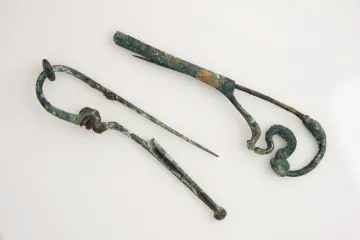
Fibula, Italic, ca. 6th century BCE, Caverzano, Belluno, Italy. Cast bronze. Exhange with Peabody Museum at Harvard University, April 1941. ASM A-2377 (right) / Fibula, Italic, CA. 6th century BCE, Caverzano,Belluno, Italy. Cast bronze. Exchange with Peabody Museum at Harvard University, April 1941. ASM A-2380 (left)
A fibula is a type of ancient clothing fastener, often found in burial contexts. In Etruscan/Italic burials such as those in the necropolis of Caverzano in the Veneto region of Italy, specific shapes can be associated with the gender of the deceased. For example, these fibulae of serpentine shape are associated with male burials. The loop of pin A-2380 (left) holds a corroded amber bead. Amber in the ancient Etruscan world originated in the Baltic region and was brought into Italy through trade networks in central Europe.
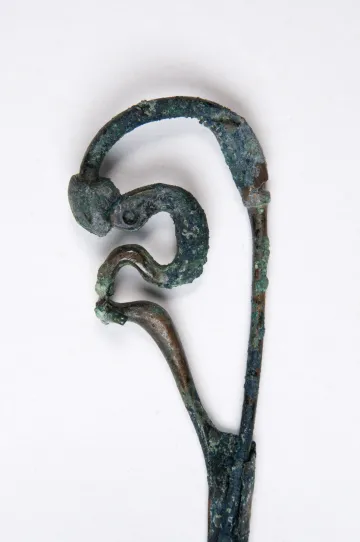
Detail of A-2377.
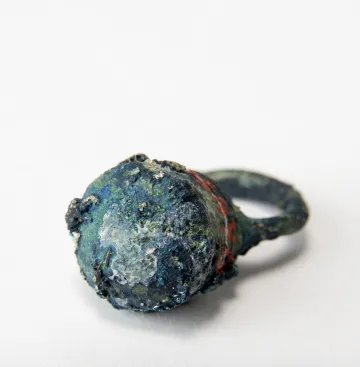
Finger Ring, Probably Roman period, 2nd-4th century CE, Caverzano, Belluno, Italy. Cast bronze. Exchange with Peabody Museum at Harvard University, April 1941. ASM A-2305.
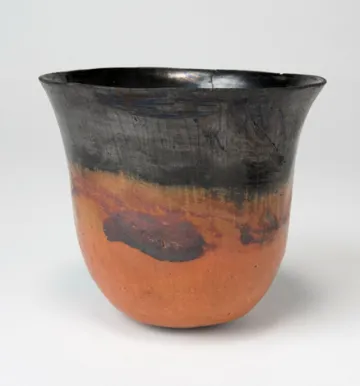
Nubian Black-topped Red-polished Ware Beaker, ca. 1700-1550 BCE. Excavated by George A. Reisner at Kerma, Nuba (modern Sudan). Christmas Gift from Reisner to Robert Humphrey Forbes, first dean of the college of agriculture at the University of Arizona, 1920. Gift of Robert Humphrey Forbes to ASM, 1958. ASM A-13042.
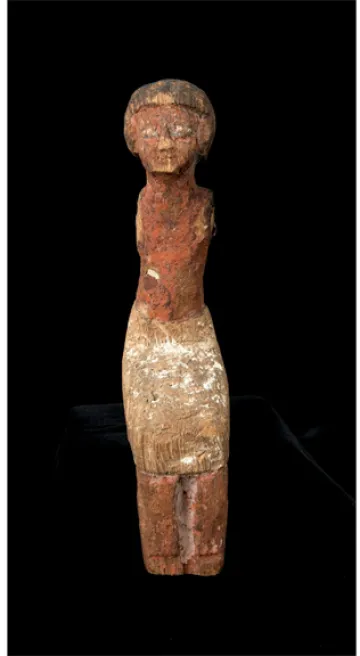
Seated Wooden Tomb Figure, First Intermediate Period to first half of Middle Kingdom, ca. 2100-1878 BCE. Collected by David E. Heineman in Egypt ca. 1900, donated by Robert E.S. Heineman, UA and Arizona Bureau of Mines, 1940. A-1479.
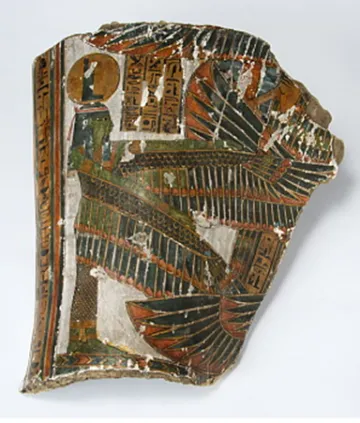
Mummy Cartonnage Fragment, Later 3rd Intermediate Period, Dynasties 22-25, ca. 945-656 BCE. Gift to ASM by Alice Hubbard Carpenter, May 1955. Collected by Bela Hubbard in Egypt, possibly in the 1880s. ASM A-12565.





